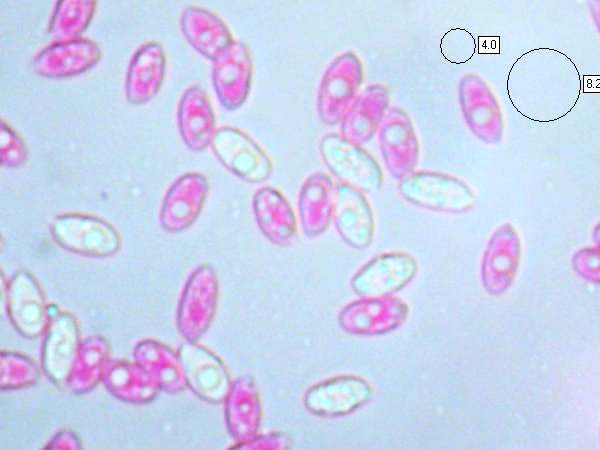Clitocybe phaeophthalma (Pers.) Kuyper - Chicken Run Funnel
Phylum: Basidiomycota - Class: Agaricomycetes - Order: Agaricales - Family: Tricholomataceae
Distribution - Taxonomic History - Etymology - Identification - Toxicity - Reference Sources
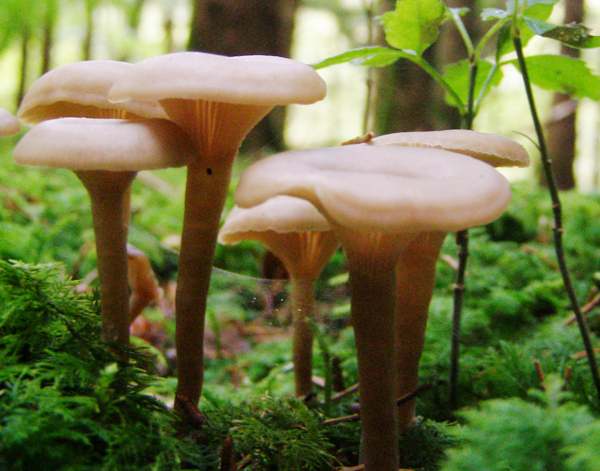
There are several small whitish funnels that not only look like the Chicken Run Funnel but also grow in the same kinds of habitats. Identifying many of them with any certainty requires cereful microscopic study... except for Clitocybe phaeophthalma, which has a unique and very unpleasant smell that is instantly recognisable by anyone who has ever kept chickens.
The Chicken Run Funnel is a woodland mushroom most often encountered under broadleaf trees.
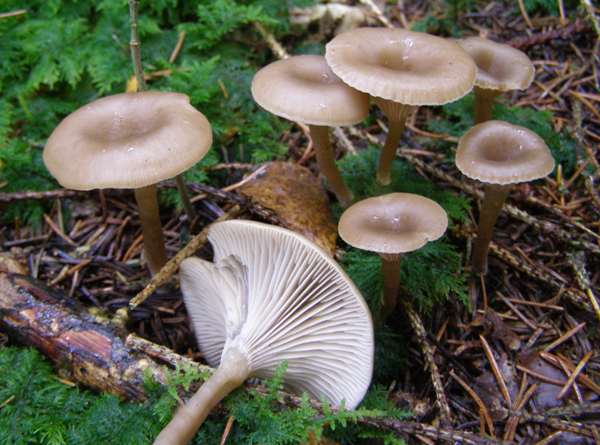
Distribution
Found in all kinds of woodland throughout Britain and Ireland but most commonly in the south, these gregarious smelly but otherwise nondescript toadstools are found also in many parts of mainland Europe and in North America.
Taxonomic history
This species was described in 1828 by Christiaan Hendrik Persoon, who gave it the binomial scientific name Agaricus phaeophthalmus. (At that time most gilled fungi were initially placed in a gigantic Agaricus genus, which has since been slimmed down with most of its contents being transferred to other newer genera.)
In a 1981 publication in Persoonia, Dutch mycologist Thomas W Kuyper (b. 1954) redefined this woodland mushroom as Clitocybe phaeophthalma, which is now its generally-accepted scientific name.
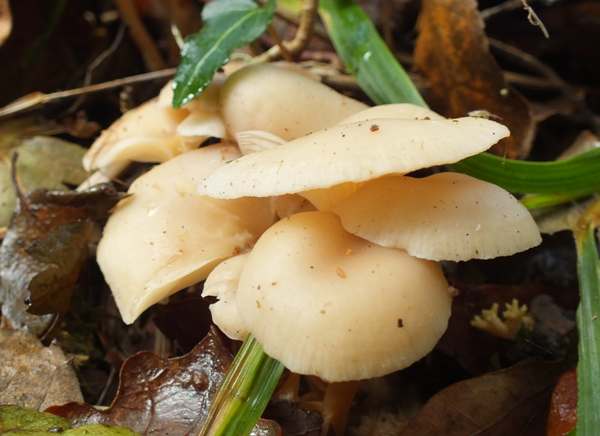
Synonyms of Clitocybe phaeophthalma include Agaricus phaeophthalmus Pers., Agaricus hydrogrammus sensu auct., Clitocybe gallinacea sensu Rea, Clitocybe hydrogramma sensu auct. mult., sensu NCL, and Omphalia hydrogramma sensu auct.
Note: 'sensu' comes from the Latin sensus means 'in the sense of'. You will see 'senso lato' which implies 'in the broadest sense'; 'senso stricto' which means 'in the strict (i.e. narrowest) sense'; 'sensu auct.' is short for sensu auctorum, which indicates a different binomial used by other authors after the original author had applied a binomial scientific name; and 'sensu auct. mult.' is short for 'sensu auctorum multorum' and means 'in the sense of many authors'.
Agaricus fritilliformis Lasch, and Clitocybe fritilliformis (Lasch) Gillet are also synonyms of Clitocybe phaeophthalma.
Etymology
Clitocybe means 'sloping head', while the specific epithet phaeophthalma comes from phae- a prefix of ancient Greek origin (derived from phaeos, meaning dusky), and -opthalma from the Greek noun ophthalmos meaning an eye - the implication being that the cap of this mushroom has a darker central 'eye'.
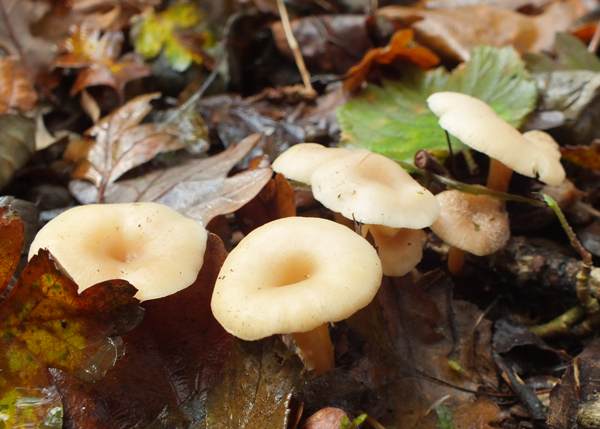
Toxicity
Clitocybe phaeophthalma is of unknown edibility, and as some pale funnel mushrooms are known to be deadly poisonous that makes eating Chicken Run Funnel mushrooms very dangerous indeed. The symptoms of poisoning by some of the white-capped Clitocybe species are those associated with muscarine poisoning. Excessive salivation and sweating set in within half an hour of eating these fungi. Depending on the amount consumed, victims may also suffer abdominal pains, sickness and diarrhoea, together with blurred vision and laboured breathing. Deaths of otherwise healthy people from eating these fungi are very rare, but anyone with a weakened heart or with respiratory problems is much more at risk.
Identification guide
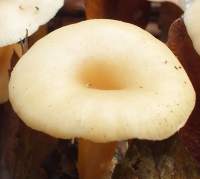 |
Cap2 to 5cm across; convex, flattening and developing a shallow central depression; smooth, usually with a finely striate margin; slightly viscid when wet; pale pinkish buff to greyish buff but darker in the centre; hygrophanous, drying very pale cream.. |
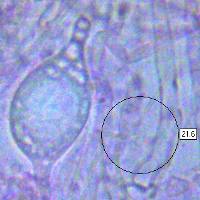 |
Pileus hyphal structureThe cap cuticle contains distinctive spherical or broadly fusiform cells (left) 15 to 25μm across. |
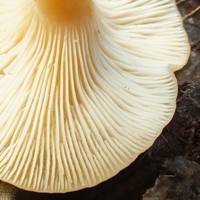 |
GillsDecurrent; moderately crowded; white, turning cream with age. Stem2 to 4.5cm long and 3 to 7mm diameter but usually tapering towards the base; smooth at the apex, often more silky or even finely downy towards the base; initially creamy white, becoming ochre with age; no stem ring. |
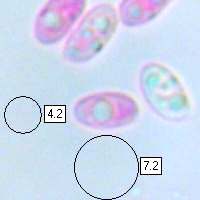 |
SporesEllipsoidal to subglobose, smooth, 4.5-7 x 3-4.5μm. Spore printWhite.
|
Odour/taste |
Odour reminiscent of a chicken run or a hen house; taste bitter. |
Habitat & Ecological role |
Saprobic, usually in tufted groups on leaf litter in broadleaf woodlands, especially under beeches; occasionally on needle litter in coniferous forests. |
Season |
July to November in Britain and Ireland. |
Similar species |
Calocybe gambosa, St George's Mushroom, has thicker cap flesh and a mealy odour; it occurs in similar habitats but mainly between late April and early July. Many other whitish funnel mushrooms (Clitocybe species) look very similar to Clitocybe phaeophthalma, but the strong odour of the Chicken Run Funnel makes it stand out from the crowd. |
Reference Sources
Fascinated by Fungi, 2nd Edition, Pat O'Reilly 2016, reprinted by Coch-y-bonddu Books in 2022.
British Mycological Society (2010). English Names for Fungi
Funga Nordica, Henning Knudsen and Jan Vesterholt, 2008.
Dictionary of the Fungi; Paul M. Kirk, Paul F. Cannon, David W. Minter and J. A. Stalpers; CABI, 2008
Taxonomic history and synonym information on these pages is drawn from many sources but in particular from the British Mycological Society's GB Checklist of Fungi.
Fascinated by Fungi. Back by popular demand, Pat O'Reilly's best-selling 450-page hardback book is available now. The latest second edition was republished with a sparkling new cover design in September 2022 by Coch-y-Bonddu Books. Full details and copies are available from the publisher's online bookshop...
